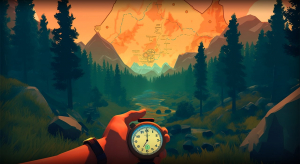For years now, video games have been story-driven.
The medium is considered one of the best storytelling mediums out there. Some of the best stories in games are on par with the best stories on other mediums, such as movies and books. Many a video game development company, even adapts stories from other formats to games.
There is a lot of variety to these stories as well. There are games where you can take on the role of a magical being and participate in epic battles with world-ending repercussions. There are games where you play the role of a con man who must climb the top of the crime syndicate in a particular city. There are even games where you play a detective aiming to solve one case after the other.
But not all genres and types of games have amassed great storylines. There are in fact, genres of games that have never had much storylines to begin with. Some have even gone on to never experiment with storylines in these games.
Among these are casual games.

Casual games are a type of video games that are focused on relaxed gameplay. The motivations of casual gamers are different, and they usually play to reduce stress and to pass the time.
There are a few characteristics that are hallmarks of casual games. The chief one is that casual games are accessible. Hence, if you look at the demographic statistics of top casual games, you can observe that the audience is all over the place regarding age, gender, location, etc. The same game might be a favorite of both a child and an elderly person.
Casual games are also geared towards shorter playing sessions. Anyone can pick up the game anytime they have a tiny sliver of time, between meetings or during a commute. This has led to a surge in the popularity of this genre of games since the very beginning, which mobile game development services providers have capitalized on.
In the past, casual games were primarily played in browsers on the PC. There existed games on mobile, but there were relatively few. However, the advancement of smartphones and wide adoption led to the proliferation of casual games. The ease of gameplay led to a vast percentage of the population adopting it.
There are numerous reasons why storytelling in casual games has become more rampant.
The main reason is the inherent attraction human beings have towards stories. We are a species that thrives on stories. We relate to each other through stories. Stories are how we communicate and build connections. We are all natural storytellers and ardent fans of stories by our very nature.
The second reason is also derivative from the same concept. It is that stories in games are an excellent method to engage players. It is a proven method to ensure the players stick around for the long term. It is, at times, helpful for long-term retention. Because good stories hook players and prompt them to return again and again to enjoy the game.
Third, characters and plots create emotional resonance. The players would put themselves in the characters’ shoes and be able to relate to the events unfolding within the narrative. This creates an emotional investment from the players’ side towards the game.
Fourth, unlike all other storytelling mediums, players are active agents in games. In other mediums, be it movies or books, the player is a passive engager, bearing witness to the storyline as an outsider. In contrast, in games, you are directly placed into the role of the main character and have to react to the events that happen to them.
This makes storytelling an essential aspect of many games. It underscores the importance of storytelling in casual games.
However, a few challenges are inherent in using stories in casual games. And why more and more companies have gained an understanding of the importance of storytelling in casual games.
The first one is that unlike in genres like RPGs and adventure games, players do not play an active role in casual gameplay. Instead, the story is not as tethered to the gameplay, owing to the audience’s preferences.
The second is that the storylines should be lean. This means that build-ups should be faster. The transition from one story beat to the other beat should happen in succession. Because session times are lower, possibly increasing the time between story beats, players might pick up the game at different times.
One solution to this issue that many casual game developers have found is to serialize the stories. This creates anticipation among players week after week. The players would eagerly wait for the next story in the installment.
The second thing to consider is that the story has to be visual. You can’t just add a lot of text inside the story and ensure it works. Most of the time, it won’t. Because players are not interested in reading a lot of text in casual games. These players prefer the gameplay to transition quickly from one session to the next. Hence, the bulk of the storytelling should be in a visual format with minimal text implemented.
The stories should also be tied in with the progression. Game stories are tethered to the gameplay, and the progression within the storyline should also reflect progress within the gameplay progress. The narrative design should be done so that it ties in neatly with the progression system.
Finally, there is the concern of monetization. Games are not monetized if they belong to the casual game genre, using traditional monetization methods such as upfront payments. Instead, these are monetized using micro-transactions, relatively minor payments made inside the game for specific in-game benefits such as advancement or cosmetic enhancements.
These also should be looked into within the storyline. Designers must carefully think about how these can be incorporated into their games. How to implement the microtransactions within the scope of the storyline.

Below, you can find a few examples that showcase the importance of storytelling in casual games and how other have implemented within them:
Choices is a narrative-based casual game with numerous stories to explore. You have horror, romance, fantasy, adventure, and many other stories from different genres to immerse yourself in.
The game has millions of players worldwide. It also has in-depth character customization options that let you feel like you are part of the narrative. It is one of the best choose-your-own-adventure games.
This is a match-3 casual game that is centered around a Greek mythological theme. During the gameplay, you encounter numerous heroes from mythology, such as Zeus and Perseus.
There are different things to unlock and different stories in this casual game to explore within.
Dark Parables is a game in the hidden object/puzzles genre. The series has numerous games, each with its own set of stories.
The central protagonist of the game is a mystery detective. A lot of classic detective stories inspire the game. The game is also tied in with fantasy-inspired myths such as Sleeping Beauty, Black Forest, and Red Riding Hood.
Mystery Case Files is a hidden object puzzle game that features numerous stories. Numerous puzzles are scattered around specific locations, and the player must solve them all.
The series has several games, each with stories and puzzles to solve.
In the game, the player takes on the role of a detective. As the detective, the player must engage with each puzzle. The difficulty of the puzzles varies from one to the next. Some of them are high in difficulty, and some of them are not.
The player completes more challenging puzzles, gaining skills as they go up in the game. Progressing within the game further unlocks more storylines the player can immerse in.
Florence is a game that has an interactive story. It is an acclaimed game featuring a central protagonist as they go about their lives.
Like many casual games that feature storylines, this one is told primarily through visuals. The myriad of information communicated to the audience about the protagonist and their life is done through different visual game storytelling techniques.
The game’s story is pieced together through multiple chapters spread out across the game. There are also different puzzles for the player to solve.
Stories engage us. These can be vital parts of games to entertain players long-term.
Engagement is essential to keep the players coming back for more. If the experience within a game is not rewarding or entertaining, the player will uninstall the game. The player will go off to another game because there are a myriad of games offered to us that we can jump to at any time we want.
Long-term retention is important because the longer the players keep playing, the better the monetization. Because the longer the players are engaged, the more they will spend inside the game in microtransactions. Also, long-term engagement results in better goodwill for the game, which can help gain more users.
We at Juego Studios are a team of 300+ game development experts, ready to create the game you want. Our team has delivered 500+ games over the past decade, using the latest game engines, such as Unity and Unreal.
Get In Touch
Recent Posts